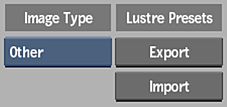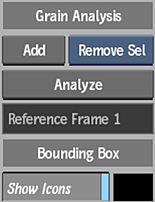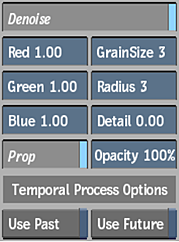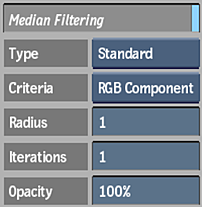Denoise Menu Settings
Setup Settings

Image Type box
Select the type of image data that is input into the node or tool. This determines the type of transformation applied to the input clip.
Export button
Click to export a Denoise setup to be used as a Lustre Degrain preset.
Import button
Click to open the browser to select a Lustre Degrain preset to import.
Grain Analysis Settings

Add Bounding Box button
Adds a new sub-region. Click and drag the bounding box in the image window to set the location.
Remove Bounding Box box
Select an option to remove the currently selected bounding box or all the bounding boxes.
Analyze button
Click to determine the grain structure.
Reference frame field
Displays the frame number that is analysed. You can use this frame analysis as a reference that can be edited and applied to the clip.
Show Icons button
Enable to display all the defined bounding boxes.
Bounding Box colour pot
Displays the colour used for the border of the bounding boxes. Editable.
Denoise Settings

Denoise button
Enable to use noise removal on the clip.
Red Gain field
Displays the gain for red channel colour values. Editable.
Green Gain field
Displays the gain for green channel colour values. Editable.
Blue Gain field
Displays the gain for blue channel colour values. For film scans, the grain is often greater in this channel. Editable.
Proportional button
Enable to change gain values proportionally for all three colour channels.
Grain Size field
Displays a value in pixels that is proportional to the size of the grain. The default value is 3, but may be higher for 4K images. Editable.
Smoothing Radius field
Displays the blur radius. For smoother results, a higher value will add more pixels to the blur, but increase rendering time. Editable.
Detail field
Displays the amount of detail to preserve when the Smoothing Radius is set to a high value. It is recommended you enter 0.05 to 0.15 as an initial value. Editable.
Opacity field
Displays a percentage of the level of opacity between the source image and the output with the applied grain filter. Editable.
Use Past button
Enable to compare with pixel data from previous frames.
Use Future button
Enable to compare with pixel data from subsequent frames.
Histogram Settings

Histogram box
Select to display the red, green, blue, or luminance histogram in the graph. Select Current Curve to display the histogram for the currently selected Curves Channel.
Curves Channel box
Select to highlight the red, green, or blue channel curve in the graph.
Home button
Reverts to the original view.
Reset box
Resets the curve view.
Set Key button
Sets the current values for the selected channels in the current frame.
Delete Key button
Deletes the selected keyframe or curve.
Reset Key button
Select to reset the current curve or all the curves to default.
Median Filtering Settings

The Median Filter removes noise by calculating the median value for each pixel (the most probable pixel value) and applies an edge-preserving smoothing filter.
Median Filtering button
Enable to use the median filter.
Type box
Select the filtering mode.
Options are:
- Standard: Applies the standard fitering algorithm.
- Advanced: Applies a more advanced filtering algorithm, but is more resource intensive. Use the Advanced Filter Mode on particularily noisy shots.
Criteria box
Select the ranking criteria by which the median value is chosen.
Options are:
- Luminance :Uses the pixel luminance value to calculate the median value.
- RGB Vector: Uses the RGB coordinate values to calculate the median value.
- RGB Component: Uses the R, G and B channels independently to calculate the median value.
Radius field
Displays the size of the filtering region in pixels from the centre. A higher value results in more pixels being taken into account when calculating the median value. Editable.
Iterations field
Displays the number of times that the filter is applied recursively. Editable.
Opacity field
Displays how much the result of one median iteration is combined with the original input. Editable.
